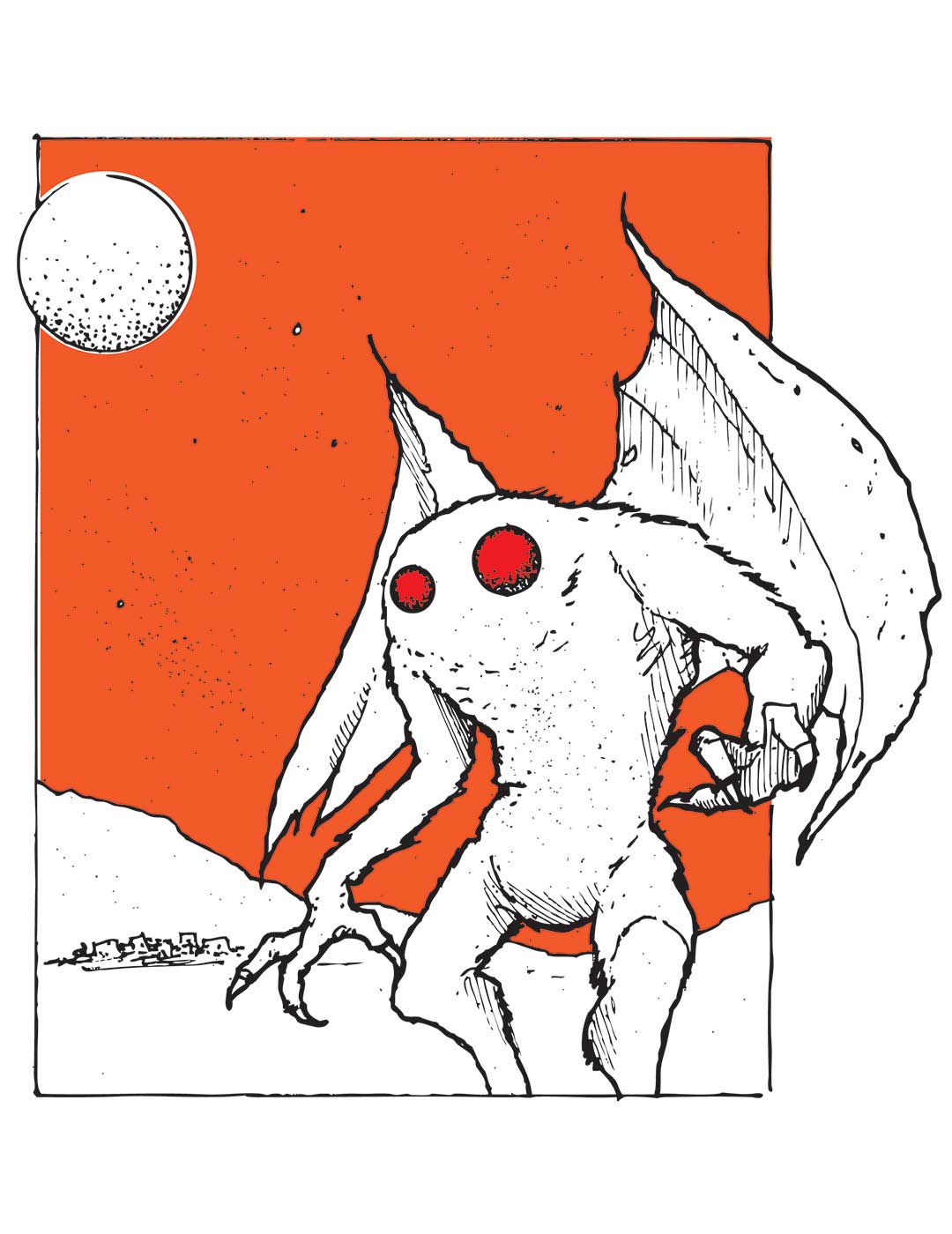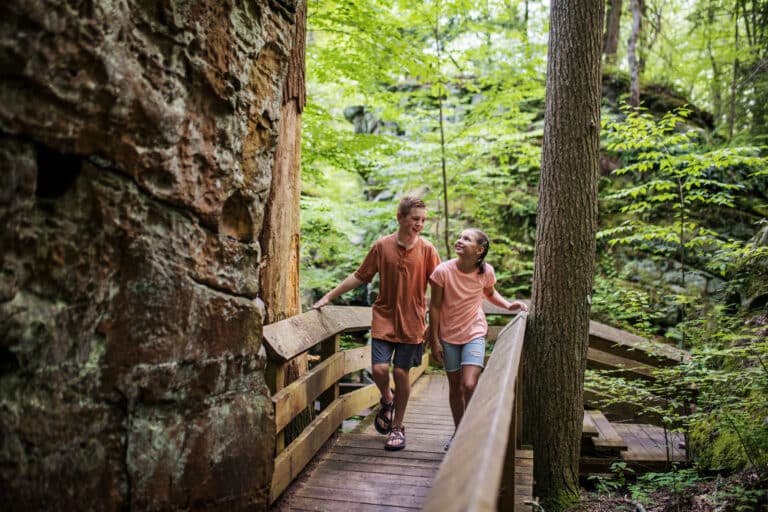Mothman and the Flatwoods Monster. Bigfoot, Brown Mountain Lights, and the Bell Witch. Are these mysteries folklore or fact?
It’s not surprising that a 480-million-year-old mountain range would inspire legends of unexplained animals darting through the darkened forest or strange and ghostly apparitions appearing in the night sky.
For generations, myths and superstitions have been passed down through the oral traditions of native tribes and early settlers, gaining a foothold in our Appalachian culture. Some scholars believe that the danger and isolation of early mountain life gave birth to many of the legends that still exist today, banging around in our brains and compelling us to take an extra look over our shoulder should we find ourselves alone in a dusky forest or a creaky old cabin.
Michael Rivers, lead investigator of the Smoky Mountain Ghost Trackers and an author who has written extensively about Appalachian folklore, says that the Appalachian Mountains are ripe with paranormal activity. Though it’s hard to say why stories of unexplained phenomena pop up in these mountains, Rivers says that fear can easily get the best of people. “Your psyche has a tendency to get away from you,” says Rivers. “If you hear things that go bump in the night and you swear you don’t have a pipe rattling or anything like that, you think it’s a spirit,” he says. “Or you happen to catch something out of the corner of your eye and you swear it’s a ghost. It’s not that you’re crazy. It’s just that your imagination and your emotions can fool you.”
Whether our collective imaginations are running wild or we’re really sensing something otherworldly, stories of ghosts, UFOs, terrifying man-sized animals, and other hair-raising tales abound in these Blue Ridge Mountains. We took a look at six of the most popular legends in our region. Dive deeper at your own risk.

Bigfoot
Imagine you’re deep in the woods when you spot a sudden movement through the trees. The animal—or whatever it is—is large and covered in dark fur. Is it a bear? You stand frozen in place, eyes locked to that shadowy spot in the woods, waiting for the animal to move. Your heart pounds in your chest and you realize, jarringly, that the sounds of the forest have died. On the ground, there’s an imprint—like a human foot but much larger, nearly two feet long and eight inches wide. Suddenly, you’re certain of what you saw, and it definitely wasn’t a black bear.
Known around the world as Sasquatch or Yeti and locally as Wood Booger or Boojum, Bigfoot is an ape-like creature that conceals itself in the deep, dark forest, leaving behind footprints so large they could not belong to any man.
The tale of Bigfoot has been traced back to the European Wild Man, a mythical figure that had hair all over his body and lived like a beast. The Wild Man can be found in literature as early as the second century BC. Stories of Bigfoot also abound in Native American oral tradition, and the unexplained ape has been studied by scientists and scrutinized on the Internet. Jane Goodall has even weighed in on Bigfoot’s existence, telling reporters that she wants to believe that Bigfoot is real.
There’s no doubt about Bigfoot’s existence in Phil Smith’s eyes. Smith of Gate City, Virginia, is co-founder of the Blue Ridge Monsters and Legends Facebook Group where members come to share their stories of unexplained encounters with the hairy bi-pedal. When Smith was a boy, he says he had his own run-in with Bigfoot.
Smith says that one cold November night he was riding his bike home after dark when he heard a friend run up behind him. “He was out of breath and anxious,” remembers Smith. “He said, something is following me. When I move, it moves. When I stop, it stops.” Spooked, Smith took a shortcut home through his grandparent’s backyard. As he rode past the grapevines, he heard something moving through the brush behind him. He turned to look. “I had to,” he says, and there beside the grapevines was a seven-foot creature. “It was leaning forward making a hump where its neck and back join,” says Smith. “The moonlight was shining through its hair. It didn’t make a sound. Needless to say, I made a hasty departure home.”
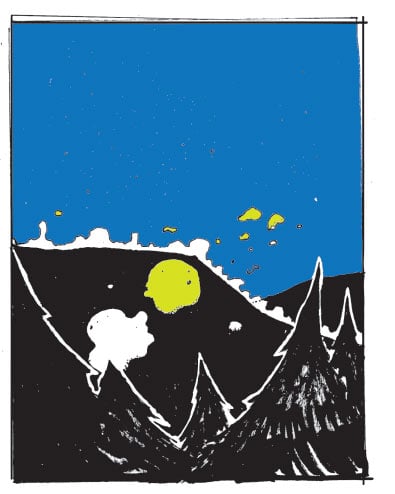
The Brown Mountain Lights
In the dark skies above Brown Mountain, North Carolina, eerie ghost lights have been spotted in the night sky for over a century. To many eyewitnesses, the lights appear as glowing orbs that hover in the sky above the mountain before suddenly disappearing or soundlessly exploding. The first reported sighting of the Brown Mountain Lights was in 1913 by a fisherman who claimed to see odd red lights dancing above the horizon. Sightings continued, and in 1922 the U.S. Geological Society investigated, determining that the Brown Mountain Lights were really just the headlights of cars or passing trains. But a major flood in 1916 changed that theory. The raging waters washed out roads and bridges and took out power for several weeks—but the Brown Mountain Lights were still spotted in the night sky.
Bluegrass songs claim that the lights are the ghost of a slave searching for his lost master. An episode of the X Files reasons that the lights are caused by UFOs. Popular Native American folklore says that a bloody battle between the Cherokee and Catawba tribes took place on the mountain. Many lives were lost. The lights, claim the legend, are the ghosts of grieving women still searching the mountainside for the bodies of fallen warriors.
But not every story of the Brown Mountain Lights is steeped in superstition. In July 2016 the Charlotte Observer reported that Forest Service officers had reported close-up encounters on the mountain with beach ball sized orbs that floated by and then vanished. And in August 2016, local TV station WLOS reported that scientists from Appalachian State University believed to have captured images of the Brown Mountain Lights on two digital video cameras. Though scientists have not been able to determine what causes the lights, ball lightning and naturally occurring mountain gases are two widely accepted theories.
If you want to find out for yourself, the best time to see the Brown Mountain Lights is September through early November. The lights can be observed on the Blue Ridge Parkway at the Brown Mountain Light Overlook located at milepost 310 or the Green Mountain Overlook at milepost 301. The City of Morganton, North Carolina even recently helped to improve the Brown Mountain Overlook on North Carolina Highway 181 for the purpose of attracting curious visitors hoping to catch a glimpse of the ghost lights.

Mothman
Back in 1966, Point Pleasant, West Virginia—located at the confluence of the Ohio and Kanawha Rivers—was a sleepy town of a couple thousand people. But it was rocked by an unidentifiable visitor on November 12, 1966, when gravediggers at a cemetery in Clendenin, West Virginia, about 80 miles from Point Pleasant, claimed to see a man with wings lift off from a tree and fly over their heads. Three days later, two young couples were driving together near an abandoned World War II TNT plant about five miles north of Point Pleasant when they saw a “large flying man with 10-foot wings,” and eyes that “glowed red.” They tried to flee the unidentified animal, speeding down the road at a reported 100 miles per hour, but the creature followed them back to Point Pleasant city limits. They were so spooked by their experience that they went directly to the police. Newspapers dubbed the creature Mothman. The national press picked up the story, and Mothman became a sensation.
Over the following week, there were at least 8 more reported sightings in and around Point Pleasant of a man-like bird with large wings. One such account came from volunteer firefighters Captain Paul Yoder and Benjamin Enochs. According to the Gettysburg Times, Yoder and Enochs claimed to have seen a “very large bird with large red eyes.”
Others refuted the sightings, believing that residents of Point Pleasant were actually seeing a sandhill crane that had wandered out of its normal migration route. “There were hundreds of eyewitnesses,” says Jeff Wamsley, owner of Point Pleasant’s Mothman Museum. Born and raised in town, Wamsley was only five years old when the Mothman showed up and began terrorizing his neighbors.
Over the following year, the oddities continued. Reports of UFOs and suspicious men in black began streaming in to the Point Pleasant authorities. And the Mothman sightings continued.
Then, ten days before Christmas in 1967, tragedy struck. While the Silver Bridge that connected Point Pleasant to Gallipolis, Ohio was teeming with rush-hour traffic, the bridge collapsed, killing 46 people. Reportedly, some claimed to have seen the Mothman at the bridge shortly before its collapse and believed its presence was a harbinger of doom.
“The fact that the UFO sightings, men in black presence, and the Silver Bridge disaster all happened during the Mothman sightings intrigues many people,” says Wamsley. “It’s a fascinating turn of events for a small town like Point Pleasant.”
For his part, Wamsley does believe that the people of Point Pleasant encountered something out of the ordinary. “I just don’t believe that many people could have made up the same story,” says Wamsley, “but what it was they saw, I don’t believe will ever be truly explained or solved.”
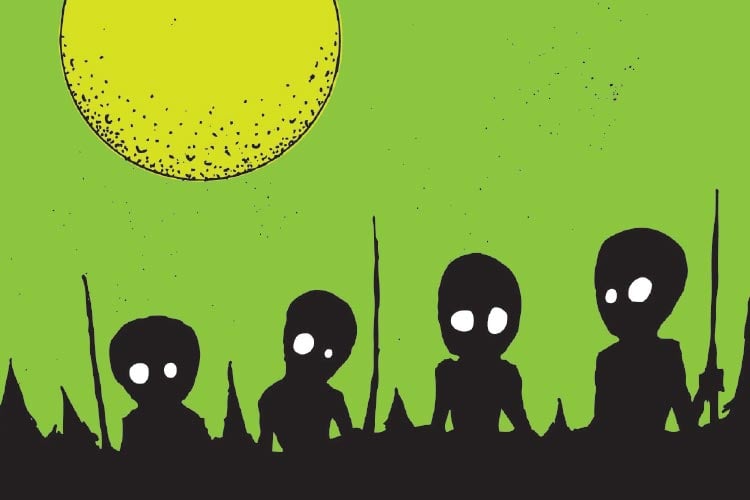
The Moon-Eyed People
According to Cherokee legend, long ago, before the Cherokee moved into the Smokies, there was a race of small, bearded white men who lived in the mountains. According to author Julia Montgomery Street, whose tale of this mysterious race is displayed in the Cherokee County Historical Museum, the men “possessed all the land from the Little Tennessee River to Kentucky, with a line of fortification from one end of their domain to the other.” The men, who lived in rounded log cabins, had large blue eyes and fair white skin and were sun-blind during the day, emerging from their homes only at night to hunt, fish, wage war and build their fortifications. Because they could only see in the dark, the Cherokee called them the Moon-Eyed People. Some believe they were descendants of a small group of Welshmen who came to America long before the Spanish and settled in the Smoky Mountains around 1170. As the legend goes, the Moon-Eyed People eventually abandoned their home—or were driven from it—and traveled west, never to be seen again.
Wanda Stalcup is the Director of the Cherokee County Historical Museum in Murphy, N.C. The museum is home to a statue that was found at the confluence of the Valley and Hiwassee Rivers in the early 1800’s. The soapstone statue is 37-inches tall and weighs 300 pounds. Many believe it is a depiction of the Moon-Eyed People.
“Everyone has their own opinion,” about the statue, says Stalcup. “[The statue depicts] twins, but they’re short like the Moon-Eyed People with little round flat faces.” Some believe that the statue represents the two rivers and others believe it is a man and a woman. “When the archaeologists came and looked at [the statue] they said they’d never seen anything to compare it to,” says Stalcup. “One reason is because they are standing, not sitting or kneeling. They think it might even be pre-Cherokee.”
Whether a small, blue-eyed race of sun-blind white men once inhabited the Blue Ridge long before the Europeans are known to have discovered America remains unknown, but the legend continues to live on.
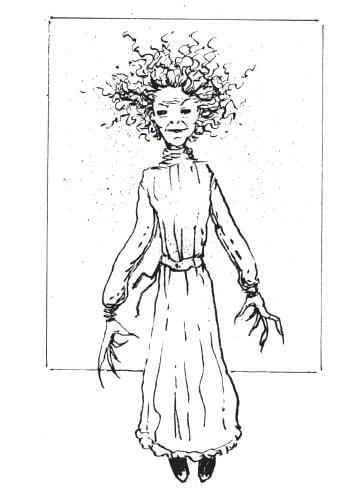
The Bell Witch Haunting
John and Lucy Bell were farmers who settled in Adams, Tennessee around 1803. They lived peacefully on their land until 1817, when the family began experiencing odd and unexplainable occurrences in their home. “They began hearing noises such as scratching, knocks on the walls, and chains being dragged across the floor,” says Pat Fitzhugh, an author and historian who has written two books about the events that occurred on the Bell farm. Over time, the noises became more intense and more frequent. Then, the Bell’s two daughters began complaining of something trying to pull at their bedcovers and pinch them while they slept.
For over a year, the Bells remained silent about the strange events taking place in their home, worried about what the members of their church might think. But the harassment wouldn’t stop, and John Bell finally confided to one of his neighbors about the strange incidents in his home. His neighbor came over and experienced the same kind of disturbances. “Before long, people all over the east and southeast knew about it,” says Fitzhugh.
People soon began traveling to the Bell farm to experience the supernatural phenomenon for themselves. Some came as curiosity seekers and some as skeptics trying to debunk what the Bells were experiencing. “Over time it seems this thing, whatever it was, fed off of attention and people’s fears,” says Fitzhugh. It eventually developed a whispering voice and within a year it could speak. “People have written down and passed through the generations accounts of what this thing allegedly said,” says Fitzhugh. “It liked to argue religion and make fun of people, except for Mrs. Bell. It stated its purpose was to kill John Bell.”
The poltergeist received the name Kate after it claimed to be the witch of a local lady named Kate Batts. When John Bell died on December 20, 1980, Kate took credit, insisting she had poisoned him because he was a bad man. After John Bell’s death, things began to return to normal on the Bell farm until Betsy Bell, the Bell’s youngest daughter, became engaged to a local man named Joshua Gardner. “Kate re-avowed her scorn and disapproval about Betsy Bell’s upcoming marriage,” says Fitzhugh. “She talked Betsy into breaking off the engagement with Joshua.” A short time later, the poltergeist said she was going to leave but promised to return in seven years.
Seven years later Kate did return, visiting John Bell Jr. who was not living at the Bell farm at the time. “They allegedly talked for three nights about the past, the present, and the future,” explains Fitzhugh. After that, the Bell Witch bid farewell and promised to return in 107 years. “That would have been in 1935. Some said she returned and some said she didn’t,” says Fitzhugh.
The real story behind the tale of the Bell Witch has never been uncovered. “Some thought it was an act of the supernatural,” says Fitzhugh. “Skeptics accused the Bell family of doing it by knowing how to act and using ventriloquism. Some thought they did it for money, but the Bell family never charged a cent to anyone staying over in their home.”
Though Fitzhugh has considered many theories, he says he can’t say one way or another what the Bell Witch truly was. “When you look at how long the story has endured and how many people have put forth theories—doctors, lawyers and preachers back in the day signed eyewitness manuscripts saying they witnessed these things,” says Fitzhugh. “It makes it more than just your standard folktale.”
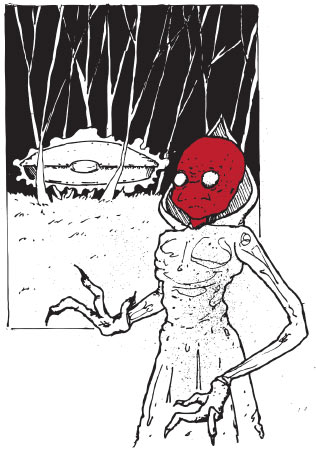
The Flatwoods Monster
In the late days of summer, 1952, two brothers named Edward and Fred May of Flatwoods, West Virginia, rushed home to tell their mother, Cathleen May, that they’d seen something unexplainable. While playing football at the playground of the Flatwoods school, they’d witnessed a bright UFO streak across the sky and land on the property of a local farmer.
Intrigued, May, her sons, and some other local boys, headed out to the farm. It was nearing dusk when they saw an unidentified object in the woods. “They saw an odd-shaped thing that appeared to be glowing red with smoke and steam coming off of it,” says Andrew Smith, Executive Director of the Braxton County CVB and curator of the Flatwoods Monster Museum. 17-year-old Eugene Lemon, a National Guardsman who’d also tagged along on the adventure, said he saw a pulsing light and pointed his flashlight toward it, revealing a pair of bright eyes in a tree and a “10-foot monster with a blood-red face and a green body that seemed to glow.” The monster then hissed and floated towards the group, causing Lemon to scream and drop his flashlight. According to newspaper reports, “several of the party fainted and vomited for several hours after returning to town.” Later, Mrs. May was quoted as saying that the monster “looked worse than Frankenstein.”
The group turned and ran down the hill, immediately reporting what they saw to the local sheriff. An hour later, several men armed with shotguns returned to the scene with Lemon. They were met with a horrible smell and, according to local reports, saw “slight heat waves in the air.” “Authorities didn’t find much,” says Smith. “What was found was gathered and sent to Washington D.C. and never seen again.”
Smith says that what makes the Flatwoods Monster so interesting is that there weren’t many UFO sightings back in the 1950s. The Flatwoods incident was only the second or third of its kind—and probably the first with so many witnesses. “It made national headlines,” says Smith.
Today, on the main road into town, there is a sign that reads “Welcome to Flatwoods: Home of the Green Monster.” The UFO sighting—or whatever that was—is in the past but not forgotten. “There’s not a consensus,” on what happened in Flatwoods that evening, says Smith. “You have your UFO true believers and skeptics who think it was a misidentified barn owl,” Smith explains. “If I had to pick one I’d say that the most commonly held thought is that the monster is a fun and interesting bit of folklore,” says Smith. “Having to decide whether it’s real or fake takes all the fun out of it.”
